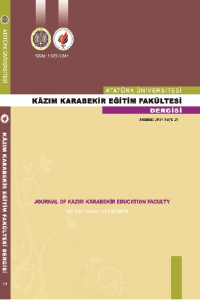Abstract
Alexandre Dumas Fils tells the story of a young girl, Marguerite Gautier, who was dishonored in the luxurious life of Paris and became “courtesan” in “The Lady of The Camellias”. The society doesn’t accept this girl, who runs the risk of leaving the courtesan for a young boy, loving her sincerely. It is possible that mercy and tolerance towards the courtesan are noticed. In the meanwhile, the readers witness the events about love that progress between “fallen” woman and a young boy and also notice the characteristics of this woman. It is set out how the men behave towards the women like her, the perspective of the society and how these women consider themselves. From time to time, the feminist rebellions are seemed in this novel. Marguerite Gautier rebels against the men, who behave towards the “fallen” woman like sale of goods. This article aims to show how the theme “courtesan” is handled in “The Lady of The Camellias” and the tolerance of Alexandre Dumas Fils towards courtesans
Keywords
References
- Balzac, Honoré de, (2004) Kibar Fahişelerin İhtişamı Ve Çöküşü, Oğlak Yayıncılık, İstanbul.
- Balzac, Honoré de, (2004)Tılsımlı Deri, Kastaş Yayınevi, İstanbul.
- Dumas Fils, Alexandre, (2003) Kamelyalı Kadın, Sosyal Yayınlar, İstanbul Goncourt, Edmond de, (1979) La Fille Elisa/La Faustin, Unions Générales d’Editions, Paris.
- Mehta, Brinda J., (1992) La Prostitution ou cette triste réalité du corps dans La Cousine Bette, Nineteenth-Century French Studies, Volume 20, Numbers3, 4.
- Mırbeau, Octave, (1994) L’Amour de la Femme Vénale, INDIGO, Paris.
- Murata, Kyoko, (2006) La Figure de la courtisane dans La Comédie humaine, Human Sciences, Vol. 1, Bulletin of Osaka Prefecture University.
- Uşaklıgil, Halit Ziya, (2006) Sefile, Özgür Yayınları, İstanbul.
- Zola, Emile, Nana, (2005) İskele Yayıncılık, İstanbul.
- Elektronik Kaynak, http: //fr. wikipedia. org/wiki/La_Dame_aux_camelias
Abstract
Kamelyalı Kadın romanında Alexandre Dumas Fils, Paris’in lüks yaşamında namusunu kaybedip kötü kadın olan Marguerite Gautier adlı genç kızın hikâyesini anlatır. Kendisini gerçekten seven bir genç için kötü kadınlığı terketmeyi göze alan bu genç kızı toplum kabul etmez. Romanda, kötü kadınlara karşı bir merhamet ve hoşgörü görmek mümkündür. Düşmüş bir kadınla bir erkek arasındaki aşk üzerine gelişen olaylara tanık olurken, bu kadının kendi dünyasına ait özellikleri de görür okuyucu. Erkeklerin böyle kadını nasıl gördükleri, toplumun bakış açısı, ayrıca bu kadınların kendilerini nasıl gördükleri gözler önüne serilir adeta. Zaman zaman feminist başkaldırılarla karşılaşılır romanda. Marguerite, düşmüş kadını bir satılık mal olarak gören erkeklere başkaldırır. Bu makale, kötü kadın temasının Kamelyalı Kadın adlı romanda nasıl sunulduğunu ve yazar Alexandre Dumas Fils’in kötü kadınlara karşı olan hoşgörüsünü ortaya koymayı amaçlamaktadır.
Anahtar Kelimeler: Alexandre Dumas Fils, Kamelyalı Kadın, Düşmüş Kadın.
Abstract
Alexandre Dumas Fils tells the story of a young girl, Marguerite Gautier, who was dishonored in the luxurious life of Paris and became “courtesan” in “The Lady of The Camellias”. The society doesn’t accept this girl, who runs the risk of leaving the courtesan for a young boy, loving her sincerely. It is possible that mercy and tolerance towards the courtesan are noticed. In the meanwhile, the readers witness the events about love that progress between “fallen” woman and a young boy and also notice the characteristics of this woman. It is set out how the men behave towards the women like her, the perspective of the society and how these women consider themselves. From time to time, the feminist rebellions are seemed in this novel. Marguerite Gautier rebels against the men, who behave towards the “fallen” woman like sale of goods. This article aims to show how the theme “courtesan” is handled in “The Lady of The Camellias” and the tolerance of Alexandre Dumas Fils towards courtesans.
Keywords: Alexandre Dumas Fils, Camille, Fallen Women.
References
- Balzac, Honoré de, (2004) Kibar Fahişelerin İhtişamı Ve Çöküşü, Oğlak Yayıncılık, İstanbul.
- Balzac, Honoré de, (2004)Tılsımlı Deri, Kastaş Yayınevi, İstanbul.
- Dumas Fils, Alexandre, (2003) Kamelyalı Kadın, Sosyal Yayınlar, İstanbul Goncourt, Edmond de, (1979) La Fille Elisa/La Faustin, Unions Générales d’Editions, Paris.
- Mehta, Brinda J., (1992) La Prostitution ou cette triste réalité du corps dans La Cousine Bette, Nineteenth-Century French Studies, Volume 20, Numbers3, 4.
- Mırbeau, Octave, (1994) L’Amour de la Femme Vénale, INDIGO, Paris.
- Murata, Kyoko, (2006) La Figure de la courtisane dans La Comédie humaine, Human Sciences, Vol. 1, Bulletin of Osaka Prefecture University.
- Uşaklıgil, Halit Ziya, (2006) Sefile, Özgür Yayınları, İstanbul.
- Zola, Emile, Nana, (2005) İskele Yayıncılık, İstanbul.
- Elektronik Kaynak, http: //fr. wikipedia. org/wiki/La_Dame_aux_camelias
Details
| Primary Language | tr;en |
|---|---|
| Journal Section | Makaleler |
| Authors | |
| Publication Date | January 20, 2015 |
| Submission Date | January 20, 2015 |
| Published in Issue | Year 2015 Issue: 29 |


